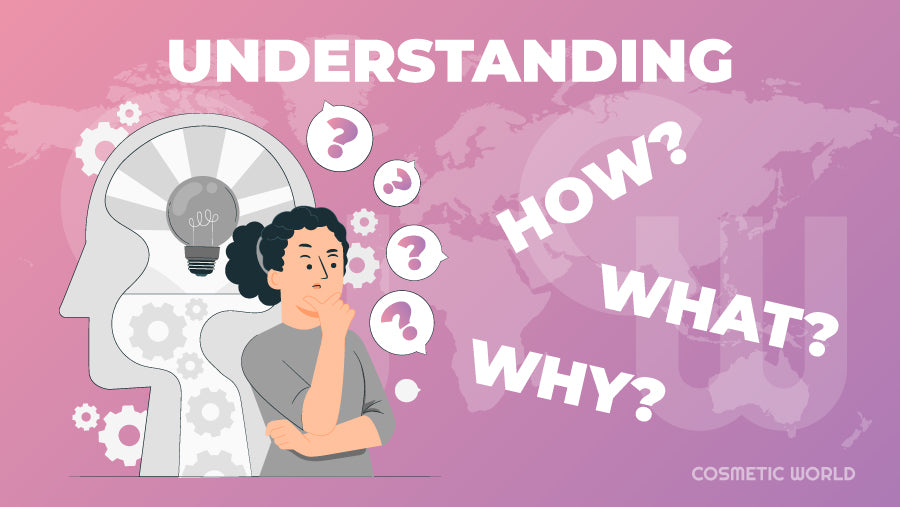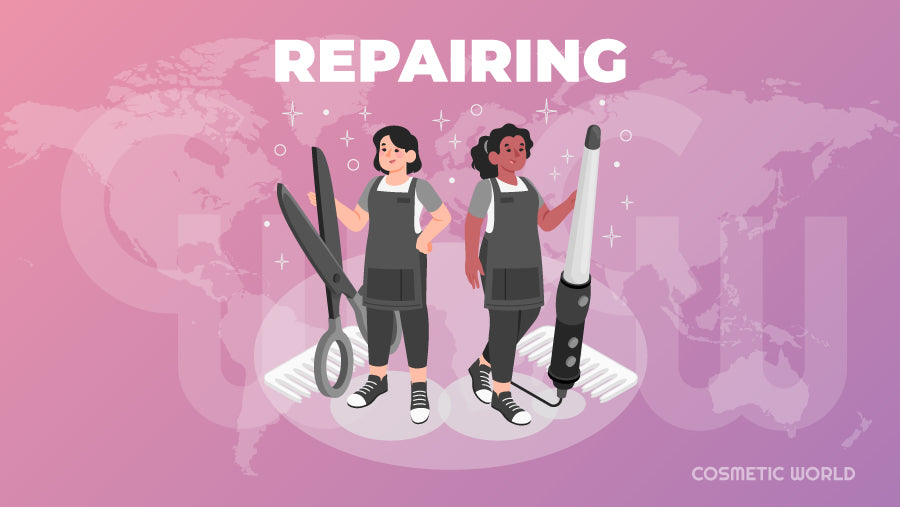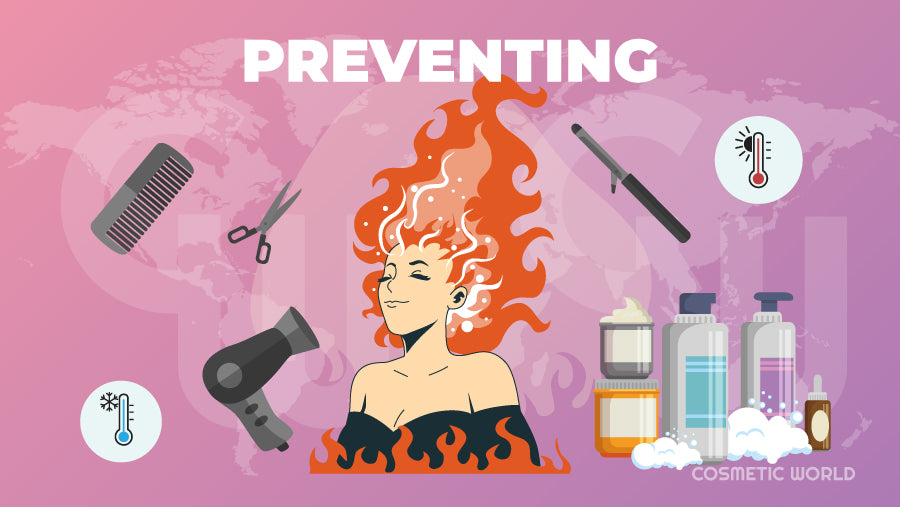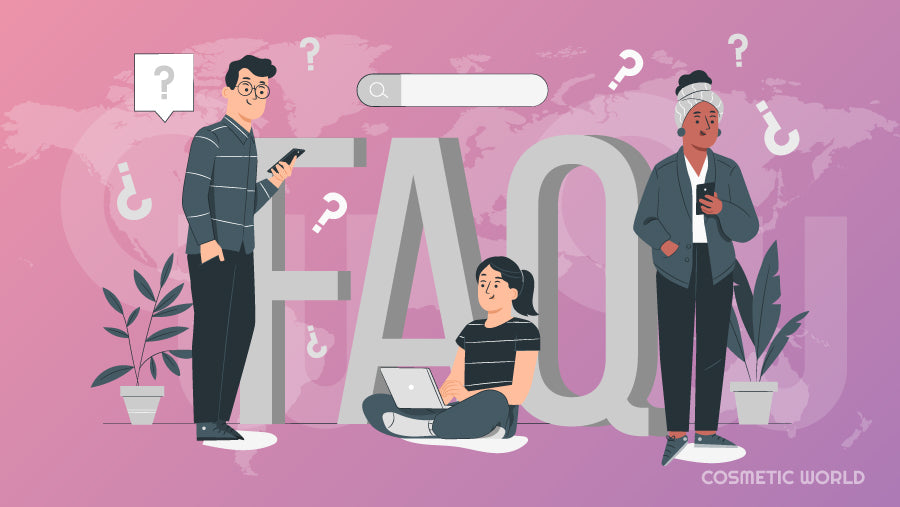Knowing how to fix heat-damaged hair is more essential than ever. Your hair is a quintessential part of your persona. But too often, it falls prey to heat styling tools, transforming from fab to drab. No more, I say! Heat-damaged hair may sound like a tragic love story, but it doesn't have to be the end. The phoenix shall rise, and so shall your gorgeous tresses!
Table of Contents
In this enlightening journey, we're exploring the hushed world of hair trauma caused by heat. We'll first unravel the mystery of how heat plays the villain in your hair story, causing havoc and leaving tell-tale signs of damage. But fret not, my lovelies! We shall reveal potent remedies, tailor-made for different hair types, to nurse your precious strands back to health. And lastly, prevention is always better than cure, so we'll step into the protective world of preventive measures. From shampooing tips to styling cues to lifestyle changes, we'll arm you with the knowledge to safeguard your hair from future harm. Now, shall we proceed?
Understanding Heat Damaged Hair

Now, ladies and gentlemen, to understand how to repair heat damaged hair, we first need to understand the enemy. So, who or what is our foe? It's heat, darling, heat damage!
What causes heat-damaged hair?
Well, do you love using your blow dryer, flat iron, or curling iron? These hot tools are our hair's worst frenemies. They give us stunning hairstyles but secretly damage our precious hair. Let's be real, we all love a little extra oomph, but at what cost?
How does heat damage hair?
It's simple science, really! When you apply heat, it changes the structure of your hair - specifically the hair shaft. Too much heat sucks out all the moisture and proteins from the hair follicles. This can cause your hair cuticles to lift, leaving your hair strand completely exposed and vulnerable. Imagine it like peeling an orange. Once the peel is gone, the juicy part is exposed and will eventually dry out. You wouldn't want to eat a dry orange, would you? Exactly!
Why is hair heat damage irreversible?
Here comes the bombshell, my dears: once your hair cuticles are damaged, it can't be undone (well... at least if it's severe damaged). Why? It's like trying to un-peel a banana - impossible! But don't panic! Even though the damage is irreversible, there are ways to fix heat damaged hair, so it looks better. So, chin up!
Identifying Heat Damaged Hair

Not sure if your hair is throwing a heat-induced tantrum? Let's run through the tell-tale signs, shall we?
Texture and Manageability Issues 🌊🌀🔧💆♀️
-
Unmanageable Hair: If your hair has more mood swings than a teenager, it's a red flag! Heat damaged hair can be stubborn.
-
Tangles And Knots: Knot today, Satan! Heat damage can cause your hair to knot up more than usual.
-
Frizz: If your hair is frizzier than a fluffy cotton candy, it might be crying out for help.
-
Changing Texture: One day it's straight, the next it's curly - that's some identity crisis! Constant heat styling can cause this.
Health Indicators 💁♀️🌟💇♀️🌿
-
Split Ends: Remember when you couldn't break a Kit-Kat in half and you ended up with a mess? That's your hair with split ends!
-
Hair Breakage And Shedding: If your hair is breaking faster than your diet resolutions, it's time for intervention.
-
Overly Dry Hair: If your hair is drier than a bad joke, it's a clear sign of heat damage.
-
Brittle Hair: If your hair is more brittle than a biscuit dunked in tea for too long, we have a problem.
Appearance Red Flags 🚩🙅♀️🔎💇♀️
-
Dull Hair: If your hair has lost its shine, it's not just playing hard to get. It's heat damaged.
-
Fading Hair Color: If your hair color is fading faster than a denim jacket in the sun, you need to address this issue.
-
Lack of Shine: Does your hair lack the shine of a fresh Krispy Kreme glaze? It's a sign of damage.
And here are some examples:
Repairing Heat-Damaged Hair

There's hope, my hair-loving friends! There are some heat damaged hair treatment options, that might help you. We can come to the rescue of our distressed tresses. But first, we must understand how to fix heat damaged hair the path to repairing heat damaged hair varies depending on your hair type.
General Treatment for Heat-Damaged Hair 🔥🔧🌿💦
Let's start with the basics. Hair masks are your new BFFs. Pamper your hair with coconut oil or olive oil masks. They work wonders to treat damaged hair by replenishing lost moisture and nourishing the hair strands. When you choose a hair mask make sure it's according to your hair type and condition.
Specific Treatments for Different Hair Types 👩🦱👨🦰👩🦳🌿💆♀️
-
Curly Hair: If you have heat damaged curly hair, you need to double up on moisture! Deep condition and use leave in conditioner to help restore your curls.
-
Straight Hair: For straight hair, use protein treatments to strengthen your locks and restore resilience.
-
Chemically Treated Hair: For chemically treated hair, be extra gentle. Use a gentle shampoo, and nourishing oils to help fix damaged hair.
Seeking Professional Help for Severe Hair Damage 🏥👩⚕️💇♀️💼
For severely heat damaged hair, it might be time to turn to the pros. They can provide treatments tailored to your hair's needs. A little expert TLC can go a long way!
Preventing Heat Damage

Prevention is better than cure, my lovelies! If you know how to prevent it, you won't need to know how to fix heat damaged hair. So, maintaining a healthy hair care routine will help you protect your lovely hair from heat damage.
Shampooing and Conditioning Tips 🚿🧴🌿
-
Pay Attention To Shampooing And Conditioning: Yes, it matters how you do it. Always shampoo with lukewarm water and rinse with cold water to close those hair cuticles.
-
Cleanse With A Repairing Shampoo: Choose a shampoo that restores moisture to your hair.
-
Detangle With A Hydrating Conditioner: Hydrating conditioners help to smoothen your hair, preventing tangles and knots.
-
Treat With A Deep Moisture Mask: A deep moisture mask will help replenish the hydration levels in your hair, making it more resilient.
Styling Tips 💇♀️💡👗
-
Use Warm And Cold Water: Remember, hot water is a big NO-NO! It strips the natural oils from your hair, leading to dryness.
-
Minimize Heat Treatment: The less heat, the better! Let your hair air dry instead of blow drying it. Especially on damp hair.
-
Always use a heat protectant: This is your hair's armour against heat styling tools.
-
Low-tension hairstyles: Tight hairstyles can lead to hair breakage. Opt for loose, comfortable hairstyles.
-
Dye less often: Chemical treatments can make your hair more prone to damage.
-
Refrain From Combing Wet Hair: Your hair is most vulnerable when it's wet. Let it dry before you comb through.
Lifestyle Tips 🌞🏋️♀️🥦💤
-
Get A Maintenance Trim: Regular trims help to get rid of split ends, preventing further damage.
-
Protect Your Hair From The Elements: Your hair needs protection from harsh winds and the sun's rays.
-
Invest In A Leave-In Conditioner: Leave-in treatments provide additional moisture to your hair, keeping it healthy and shiny.
-
Shield Your Hair With Heat Protectant: It's like sunscreen, but for your hair.
-
Invest in bond-building products: They help strengthen your hair's structure, making it less prone to damage.
-
Repair With A Bond Building Treatment: This treatment helps to mend the damaged bonds in your hair.
-
Do a weekly protein treatment: Protein treatments help to strengthen your hair, making it more resilient.
Remember to nourish your body too! A healthy diet is the secret ingredient to healthy hair!
Key Takeaways

Don't be discouraged, my darlings. Severe heat damage might be irreversible, but your hair's future isn't! It's all about prevention and proper care. Know the signs, seek help when needed, and protect your hair from future harm.
Frequently Asked Questions
Can I ever use heat styling tools again?
Short answer: 👍 Yes
Yes, you can use heat styling tools again after experiencing heat damage, but it's important to use them sparingly and wisely. Try to limit heat styling to special occasions, use a lower temperature setting, and always apply a heat protectant to your hair before styling. Also, allowing your hair to partially air-dry before blow-drying can reduce the amount of heat exposure.
How often should I trim my hair?
Short answer: Every 6-8 weeks ✂️📆
The frequency of hair trimming can depend on the condition of your hair and your personal hair goals. If you're trying to maintain a specific style or length, or if your hair is prone to split ends, every 6-8 weeks is a common recommendation. However, if you're trying to grow your hair longer or your hair is relatively healthy, you may be able to extend this to every 12-16 weeks.
Is it okay to leave coconut oil in my hair overnight?
Short answer: 👍 Yes
Leaving coconut oil in your hair overnight is usually okay and can be very beneficial for dry or damaged hair. Coconut oil is rich in fatty acids that can penetrate the hair shaft and moisturize from within. However, be aware that it may cause breakouts for some people if it comes into contact with the skin, so if you're prone to acne or have a sensitive scalp, you may want to limit the duration of your coconut oil treatments or avoid applying it close to the scalp. Always remember to cover your hair to protect your pillowcases and wash the oil out thoroughly the next day.
How long does it take for hair to recover from heat damage?
Short answer: A few months to a year ⏳🔥🛠️
The length of time it takes for hair to recover from heat damage can vary widely, depending on the severity of the damage and your hair's individual growth cycle. On average, hair grows about half an inch per month. If the damage is confined to the ends of your hair, you might see significant improvement after several haircuts, which could be a period of a few months to a year. However, if the damage extends higher up the hair shaft, it could take several years for completely healthy hair to grow out.
Is heat damage to hair permanent?
Short answer: It is not necessarily permanent 🔥🔄❓
Heat damage to hair is not necessarily permanent, but it can be in some instances. When hair is exposed to extreme heat, it can cause the hair's protein structure (keratin) to change, which can result in permanent damage, particularly if this heat exposure is repetitive. This type of damage is not reversible and the only solution is to cut off the damaged hair and allow new, healthy hair to grow in its place. However, if the heat damage is not severe, it may be possible to restore some health to the hair with intensive care and treatments, including deep conditioning masks, protein treatments, and avoiding further heat styling.
Conclusion
So there you have it, my beauties! Your comprehensive guide on how to fix heat damaged hair. It's time to rise from the ashes, let's conquer heat damage and reclaim our gorgeous locks. Remember, your hair is your crowning glory, treat it like the royalty it is.











